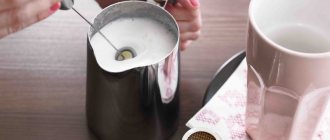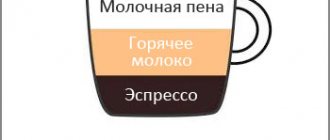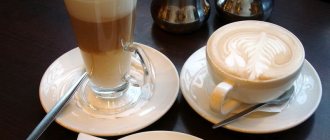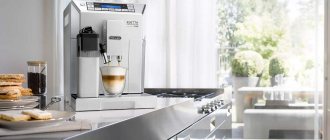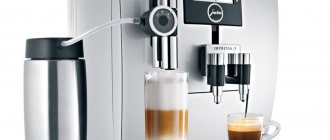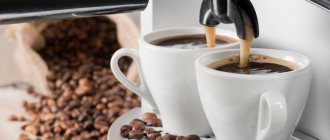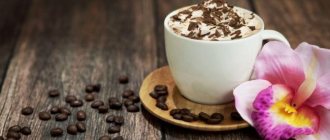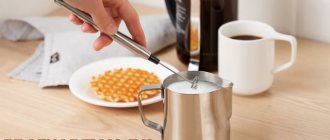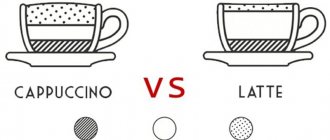Among the entire list of coffee drinks, cappuccino is perhaps second only to the classic version in popularity. Invented several centuries ago by Italian Capuchin monks, it has spread throughout the world.
Nowadays, you don’t have to visit a coffee shop every day to enjoy a delicious dessert. Happy owners of a coffee machine can easily make it in their own kitchen. For those who are just getting acquainted with how to make cappuccino in a coffee machine, it will be important to learn the nuances of preparing your favorite drink.
Story
The name “cappuccino” comes from the Capuchin Order, as the color of the drink resembles the beige-brown robes of the holy brothers. The very word cappucio (Latin: Caputium) is translated from Italian as “hood” - an indispensable attribute of the daily attire of the servants of the order.
Capuchin in a hood drinks cappuccino
The term “cappuccino” first appeared in Italian in 1930, but a similar drink, Kapuziner, existed in Austria back in the 18th century. Then it consisted of coffee, sugar, cream and egg yolks (although it is not known in what proportions). At that time, Italy was under Austrian rule; during the division of countries, cappuccino “changed his citizenship” to Italian.
Fresh milk began to be used instead of cream in the 20th century, when refrigerators appeared. Until the 1950s, the term “cappuccino” meant quite a variety of drinks (with milk or cream, with or without spices), but with the spread of coffee machines, the term was consolidated in its modern meaning.
Characteristics of cappuccino
| Suitable coffee | A blend of Arabica and Robusta medium roast (proportions may vary). 100% Arabica possible. |
| Composition and proportions | ~15 g of freshly ground coffee beans, 60-90 ml of milk (sometimes more, depending on the recipe, fat content from 3% or higher), 50-100 ml of water. |
| Coffee machine pressure | 8-10 bar. |
| Temperature of ingredients during cooking | Water temperature for espresso is 84-90 degrees, milk temperature is 60-70 degrees. |
| Cooking time | 1 – 2 minutes. |
| Volume of one serving | 150-180 ml, sometimes 360 ml (double cappuccino). |
| Strength (caffeine content) | 50-75 mg per standard serving. |
| Serving temperature | 60-63 °C. |
| Recommended Daily Value | 3-4 servings (180 ml). |
| Calorie content | 36-56 calories (depending on the fat content of the milk). Each level teaspoon of sugar adds another 16 calories to the drink. |
Attention! The figures and proportions given are arbitrary: every good barista has his own recipe, which may differ significantly from the classic one.
In the USA, skim milk is often used; other baristas, on the contrary, prefer 11% cream; there is also the half'n'half option - a mixture of cream and milk.
Recommendations for frothing milk
The main secret and difference between cappuccino and other varieties of coffee with milk is its thick, stable foam. It is possible to prepare it even at home, but it is somewhat more difficult to do than with a professional coffee machine with an automatic cappuccino maker.
Recommendations for preparing milk foam:
- The main ingredient must have a fat content of 3% and a protein content of at least 2%.
- Do not use dry powder.
- Instead of pasteurized cow's milk, it is permissible to add ultra-pasteurized, plant-based milk or cream.
- The product must be cooled to 3-6 °C.
- A cappuccino machine whips up the foam best, but it can be replaced with other available devices - a mixer, a whisk, a French press, a shaker.
- The coffee machine heats the milk as it froths. If this is not possible, it is permissible to heat it on the stove, whisking with a mixer. Another way is to put the finished foam in the microwave.
- Milk should not be heated to a temperature exceeding 60-70 °C. The boiled component will not produce foam, and the delicate sweetish creamy flavor characteristic of cappuccino will be lost.
- Large bubbles should be removed by lightly tapping the bottom of the pinscher on the countertop.
Differences between cappuccino and other types of coffee
Cappuccino coffee is very similar to a latte, but is served in smaller cups (180 ml versus 300 ml), contains less milk and more milk foam.
Macchiato (Caffe macchiato) consists only of espresso and milk without foam.
Cortado is a Spanish coffee cocktail that contains espresso and milk in proportions of 1:1 or 1:2; condensed milk is often used instead of fresh milk.
“Flat White” is a cross between a cappuccino and a latte; its characteristic feature is a very thin layer of foam, most often with a pattern.
Classic cappuccino recipe
Traditional proportions of coffee, milk and foam are 1:1:1.
Modern cappuccino is prepared in a coffee machine. First, a double portion of espresso is poured into a coffee glass, then the same amount of hot milk is added, and the composition is crowned with a lush head of milk foam. Another option is also common: the milk is not poured separately, but simply whipped up more foam, so that it not only settles on the drink in a voluminous cap, but also partially dissolves in it.
Ingredients:
- coffee (espresso) – 60 ml;
- milk – 60 ml;
- sugar - to taste.
Cooking technology
1. Pour a double shot of espresso (60 ml) into a tall coffee glass or cup with a minimum volume of 180 ml that has been preheated with steam.
2. Heat the milk to 60-70 °C, then beat it with a cappuccino maker, whisk or mixer into a fine foam until the volume doubles.
3. Holding the foam with a spoon, add milk to the espresso, sweeten with sugar if desired and stir. Place foam on top.
A cappuccino maker is a thin metal tube through which steam is supplied under high pressure. Milk frothed in this way acquires a sweetish taste and a particularly delicate structure due to microscopic bubbles.
Manual electric cappuccino maker. Many coffee machines have a separate unit for frothing milk.
Alternative recipe. Kapuziner – served in old Viennese cafes, black coffee with a few drops of heavy cream, just to get the right color.
Cooking features
In addition to the automatic method, there is also a semi-automatic method. Espresso coffee is made using this method. You need to take a large cup and pour the finished espresso. We froth the milk separately, then carefully place it in a cup.
There is another way to make cappuccino at home. To do this, you should take a Turkish coffee pot and brew espresso coffee. In a small container, you need to heat the milk, constantly stirring with a whisk. Then, similar to the previous option, it should be placed in a cup of coffee.
Instead of a whisk, you can use a mixer, so the foam will be higher.
You can buy heavy cream and whip it until you get the desired consistency. An alternative to this method is to use ready-made cream in a container. You need to put them in a cup filled with an invigorating drink. Additional ingredients can be used to decorate and improve the taste. It can be grated chocolate or cinnamon; nuts will also emphasize the exquisite taste.
Making cappuccino without a coffee machine at home
There are two methods:
- In the microwave. First, a glass of milk is heated in the microwave at maximum power until small bubbles appear on it (on average this takes less than a minute). It is important to ensure that the liquid does not “run away”. Then beat the hot milk with a whisk or mixer, successively transferring the foam to another cup. When about half of the milk turns into foam, brew a double portion of espresso, pour the remaining milk into it, and spread the foam on top.
- Manually. Coffee is brewed in a Turkish coffee pot or brewed in a French press, and hot milk is whisked. Then all the ingredients are added to the cup.
Cappuccino made in the microwave
What ingredients does it consist of?
The traditional recipe contains only 2 products - medium-ground coffee beans (Arabica or a mixture with Robusta) and milk. The first is used to prepare espresso, the second is whipped. If you have a coffee machine, the preliminary preparation of the main ingredients consists only of cooling the milk component to 4-6 °C. If there is no cappuccino maker, the foam will have to be whipped in other ways.
It can be a mixer, blender, shaker, French press. In this case, it is sometimes recommended to preheat the milk to 60-70 °C, but not bring it to a boil. If this is not done, the drink will turn out cold or you will have to put the resulting foam in the microwave for a few seconds.
Additionally, when making cappuccino, it is permissible to include in the composition:
- granulated sugar or powdered sugar;
- cream 10% fat;
- ice cream;
- caramel;
- chicken yolk;
- vanillin;
- cinnamon;
- chocolate;
- coconut flakes;
- cocoa powder;
- nutmeg;
- various syrups;
- alcoholic products;
- ice.
There is milk specifically designed for making cappuccino.
The process uses water. It is recommended to take bottled drinking water; ordinary tap water can significantly worsen the taste of the finished product.
Types of cappuccino
In addition to the traditional recipe, there are some other variations:
- Latte Art is a regular cappuccino drink, but with a pattern on the milk foam. Some baristas achieve such perfection in this art that they can even paint a portrait of a guest.
- Wet cappuccino (“wet” cappuccino) is a cocktail in which the ratio of coffee, milk and foam is shifted in favor of milk.
- Dry cappuccino (“dry” cappuccino) is the opposite of the previous option; this recipe contains less milk than other ingredients (there may be more or the same amount of foam).
- Iced cappuccino (cappuccino with ice) – in a blender, beat chilled black coffee and milk (1:2 ratio), ice cubes, sugar to taste. You can also add syrup and/or spices, or replace the milk with cream (partially or completely).
- Cappuccino Freddo (cold cappuccino) - prepared like a regular cappuccino, only all ingredients must be cold, including frothed milk.
- Babyccino is frothed milk without coffee (and therefore decaffeinated), often served with syrup.
Which cappuccino coffee maker to choose
If you decide to make cappuccino in a drip coffee maker, then this method is fast, but the coffee turns out mediocre. It has a heating element, which allows hot water to seep through the ground coffee beans and drip into the collection container.
This drink cannot be called coffee, but for lovers it is considered a good and quick option for a morning ritual. The disadvantage of such a coffee maker is its high power, due to the fact that the coffee beans do not release all their taste and aroma and the result from the prepared cup will not please you 100%.
How to serve and drink cappuccino
In continental Europe, cappuccino is traditionally drunk in the morning, mainly at breakfast, with a croissant, white toast or other pastries. In Italy, it is even considered bad manners to drink this coffee cocktail after 11 o’clock in the afternoon and/or have something substantial, like meat or a hot dish - with all the Italians’ love for coffee, they prefer espresso after lunch.
Americans drink cappuccino throughout the day and are not averse to finishing off a hearty meal with it.
As already mentioned, a classic cappuccino is served in a preheated coffee glass or porcelain cup with a volume of 150-180 ml, but in fast foods and coffee shops like Starbucks there are portions up to 600 ml in volume.
Portrait on a cup of cappuccino, it’s even a pity to drink this
